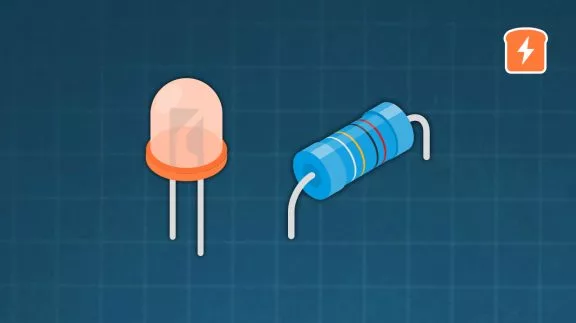LEDs (Light Emitting Diodes) have a lot of advantages over other types of lighting. They’re shock resistant and pretty tough. They’re very efficient compared to other lighting technologies.
LED Forward Voltage
One of the ratings to pay attention to when planning on using an LED is the forward voltage (VF). The VF is the voltage used up by the LED, or dropped, when current is traveling in the appropriate direction, forward. The forward voltage rating has to be met in order to light the LED, and that rating varies according to the LED color. The reason for this is that to produce different colors, different materials are used in the semiconductor portion of the LED.

LED Colors and Materials
Being able to generate different colors is a characteristic that we consider when we use an LED, because it can be used to indicate a state of a circuit. Sometimes we use green LEDs to indicate that the circuit is in good condition or red LEDs to indicate that there’s a problem. LEDs can be red, orange, yellow, green, blue, white, or violet and that color is determined by the semiconductor materials used in it. If you have an RGB LED, which has a red, green, and blue LED very close together, you can even make practically every color on the spectrum.

The way colors of individual LEDs are determined is the energy an electron loses when the electron moves from one side of the LED to the other. The amount of energy the electron sheds in the form of light is determined by the materials in the LED. The photon that is generated will have a characteristic wavelength and manufacturers have chosen materials to arrive at the desired colors. Check out this table with the range of colors and their wavelengths, materials, and the LED VF, this is also in the references section here at CircuitBread.com.

A quick way to test LEDs to find out the VF and color (if it’s not already obvious) is using the Digital Multimeter (DMM) you should always have handy. Most DMMs can drive most LEDs, however, there are some DMMs that won’t provide the voltage or current necessary to light an LED. Another reason the test might not work is if your LED requires a high current (relative to standard LEDs) or has voltage drop greater than the DMM can supply. What you should find is that red, green, or yellow LEDs have relatively low forward voltage ranging from 1.6-2.2V. However, blue and white LEDs can begin conducting from 2.5-4V.
So many projects and products have LEDs in them and it’s important to know the voltage and current required when using them. Check out the VF needs in the datasheet for your LEDs while you’re planning how to power them and you’ll be happy to see how LEDs in different colors can enhance your project.















